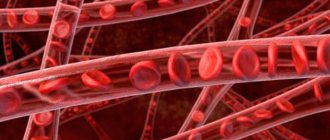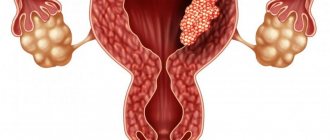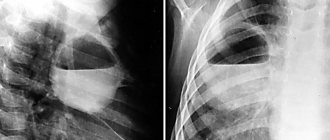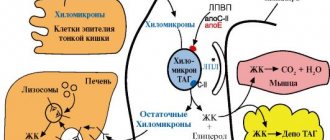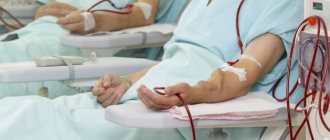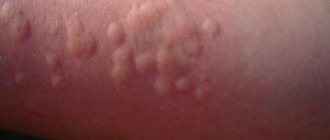Reasons for the development of the pathological condition
The very name of ITS syndrome suggests that the condition for its development is the presence of infection and toxins in the body. When the immune system and therapeutic measures inhibit the development of pathogenic microbes, the body gradually copes with the elimination of the toxins they secrete, and recovery occurs.
If the immune system is weakened and adequate treatment is not carried out, pathogens develop rapidly, releasing a huge amount of their metabolic products - toxins. This can happen with any infection:
- Purulent wounds, abscesses;
- Inflammation of the paranasal sinuses;
- Inflammatory process in any organ (pneumonia, hepatitis and liver abscess and others);
- Childhood infections (scarlet fever, measles);
- Fungal infections;
- Viral infections;
- In the postpartum period with septic infection;
- During menstruation with prolonged use of vaginal tampons.
The main “culprits” of toxemia are staphylococci, streptococci, pneumococci and those that secrete endotoxins.
Absorbed into the blood, they primarily affect the walls of the capillaries in which exchange occurs - microcirculation. First, they spasm, reducing the flow of blood into organs and tissues, then it quickly gives way to paralysis.
Blood stagnation occurs, a sharp drop in pressure, acute hypoxia (lack of oxygen), and MOF syndrome develops - multiple organ failure.
Causes of toxic shock syndrome
Although toxic shock syndrome has been studied for over 20 years, little is known about the syndrome.
The bacteria involved in the syndrome, Staphylococcus aureus and Streptococcus pyogenes, can be found on the skin and nose in approximately 20-30% of all people. They usually do not cause serious problems.
Most people have toxin-fighting proteins known as antibodies, which can protect the body from these toxins. However, for unknown reasons, a small percentage of people do not produce these specific antibodies.
It is known that bacteria can enter the body through a wound, burn, throat or vagina. They release toxins into the bloodstream, and these toxins interfere with the processes that regulate blood pressure, causing it to drop to dangerously low levels. The bacteria also attack tissues, including skin, muscles and organs.
The kidneys are especially vulnerable to toxins because they filter waste from the blood. Kidney failure is a common complication of untreated toxic shock syndrome.
Tampons
The role of tampons remains unexplained. One theory is that if a tampon is left in the vagina for a while, as is often the case with more absorbent tampons, it can become a breeding ground for bacteria.
Another theory is that tampon fibers can scratch the vagina, allowing bacteria or toxins to enter the bloodstream.
However, no evidence was found to support either theory.
Classification of ITS depending on the degree of its development
During infectious-toxic shock, there are 2 stages: reversible and irreversible. They reflect the degree of its development according to the increase in pathological changes. At the reversible stage, changes occur in the body that can still be eliminated and the patient’s life saved if qualified medical care is provided in a timely manner. In the reversible stage of infectious-toxic shock, there are also 3 stages of development:
- Early reversible shock phase - initial changes in the form of capillary spasm, blood flow deficiency and tissue hypoxia;
- Late reversible shock phase - capillary paralysis develops, blood flow slows down, blood stagnates, it is deposited on the periphery, hypoxia increases and the process of destruction of cells in the most vulnerable organs (brain, endocrine system, liver) begins;
- The phase of sustained reversible shock - hypoxia progresses, the acid-base balance is disturbed, blood stagnation leads to an increase in its coagulability, DIC syndrome (disseminated intravascular coagulation) develops, in which blood clots form in the vessels, and blood deprived of coagulation factors leaks through the walls of dilated capillaries, forming multiple bleedings – thrombohemorrhagic syndrome, the process of destruction and organ failure increases;
During the irreversible stage, blood circulation is sharply disrupted due to the formation of blood clots and hemorrhages , areas of necrosis (death) appear in the organs, they cease to function and the body dies.
Symptoms of pathology
The clinical picture of infectious-toxic shock depends on the stage of the ICT syndrome:
- In the early phase , blood pressure is within normal limits, and may even be slightly increased, the heart rate increases to 100 beats per minute, general weakness, headaches and muscle pain appear, anxiety, nervous excitement and body temperature rises to 39-41°;
- In the phase of pronounced reversible shock, pressure drops sharply (upper below 90 mm Hg), pulse above 100 beats per minute, breathing quickens, excitement is replaced by lethargy and apathy. The skin takes on a pale gray color, moist and cool to the touch;
Often there is no clear boundary between the individual phases; with lightning-fast shock, the reversible stage can be very short.
- With the onset of a phase of sustained shock, the condition sharply worsens, the pressure drops to 70 mm Hg. Art. and lower, the pulse is threadlike, frequent, reflexes and sensitivity are reduced, body temperature drops to 35-34°. Signs of organ failure appear: decreased urine output, enlarged liver, yellow skin and severe shortness of breath. The skin is bluish in color and begins to peel off;
- The irreversible stage is an extremely serious condition. The patient is unconscious, all functions are sharply depressed, the pulse is only in the carotid artery, weak, breathing is shallow and rare, kidney function stops, blue spots appear throughout the body against the background of cyanosis due to stagnation of venous blood. Body temperature drops to 32° and below. A comatose state quickly develops, which turns into clinical death.
First aid to a patient
If any of the listed symptoms are detected, you should immediately call an ambulance and begin the following steps to provide first aid for infectious-toxic shock:
- Lay the patient on a horizontal surface, raise the leg end to increase blood flow to the head;
- Unfasten tight clothing and provide fresh air;
- If possible , take a canister or pillow with oxygen from the pharmacy and let it breathe through moistened gauze or cloth;
- Control the amount of urine excreted;
- If the body temperature is high , put cold in the area of large vessels - on the neck, in the groin, put cold on the head - in the forehead, temples, crown and back of the head;
- If the patient is able to swallow, you need to give him sweet hot tea, honey water or glucose solution to drink;
- If the patient is unconscious , make sure that the tongue does not block the airway; to do this, the lower jaw is slightly pushed forward or the tongue is supported using fingers wrapped in gauze;
- Constantly monitor your pulse, respiratory rate and measure blood pressure.
If before the arrival of the ambulance the patient has stopped breathing, the pulse has disappeared and breathing needs to be performed simple resuscitation measures - closed cardiac massage and artificial respiration.
Providing medical care for ITS syndrome
The algorithm of actions when providing emergency medical care is aimed at restoring and maintaining vital functions - blood circulation, breathing and urination.
In case of shock, emergency hospitalization in the intensive care unit is indicated, so a specialized team goes to such patients.
If necessary, resuscitation measures are carried out on site: an artificial respiration apparatus with oxygen is connected, and if the heart stops, it is “started” using massage, a defibrillator or intracardiac injection.
The patient is given an intravenous infusion to replenish the volume of circulating blood, prevent thrombosis, restore hemodynamics, microcirculation, and renal filtration, which includes the following drugs:
- Glucose solution with insulin;
- Reopoliglyukin;
- Heparin;
- Albumin solution (Protein);
- Corticosteroids (Prednisolone);
- Diuretics (Furosemide and Lasix).
All these measures for the provision of emergency medical care for infectious-toxic shock are anti-shock.
Treatment of infectious-toxic shock
Patients with infectious-toxic shock are treated in an intensive care hospital or intensive care unit of the infectious diseases department. The patient is connected to an inhalation apparatus, a monitor to monitor all parameters, an intravenous catheter is placed for infusions, a catheter is placed in the bladder and a tube is placed in the stomach.
After recovery from the shock state and stabilization of hemodynamics, drugs aimed at fighting the infection are added to treatment: broad-spectrum antibiotics, sulfonamides, antiviral and immune drugs.
They are prescribed after an urgent laboratory blood test, identification of the pathogen and determination of its sensitivity to drugs. The most used antibiotics in the treatment of pathology:
- Cefazolin,
- Daptomycin,
- Cloxacillin,
- Linezolid and others.
If necessary, antifungal drugs are prescribed (Metronidazole and analogues). To successfully fight the infection, specific immunoglobulins and serums are administered.
The patient undergoes all the necessary examinations - laboratory, instrumental and tomographic. In severe cases, an EG (extracorporeal hemosorption) apparatus is connected to quickly purify the blood.
Prevention of toxic shock syndrome
Preventing Infection
Prompt and thorough treatment of body wounds can help prevent infection and any risk of toxic shock syndrome.
Care when using tampons
The relationship between TSS and tampon use is unclear, but research suggests that tampon use may be a factor. For this reason, it is important that a woman:
- always used a tampon with the lowest absorbency suitable for the menstrual cycle;
- alternated tampons with a sanitary towel or pads throughout the period.
You must also:
- wash your hands before and after inserting a tampon;
- change tampons regularly - as often as indicated on the packaging;
- never insert more than one tampon at a time;
- When using one at night, insert a fresh tampon before going to bed and remove it after waking up;
- remove the tampon at the end of menstruation.
Infectious-toxic shock in children
In children, the development of infectious-toxic shock is particularly rapid and severe. The reason is most often a late visit to the doctor for help and self-medication for various inflammatory diseases. Children at risk include:
- Developmentally delayed;
- Kept in unfavorable conditions;
- With nutritional deficiency;
- With congenital anomalies;
- Premature babies;
- With acute and chronic diseases - bronchitis, pneumonia, sinusitis, nephritis, candidiasis and other infections.
Clinical symptoms, as a rule, begin with high body temperature and lethargy of the child; all body functions are quickly disrupted. The first aid algorithm is the same as for adults; the first step is to call an ambulance.
Treatment is carried out in a specialized pediatric intensive care unit.
What is toxic shock syndrome?
Toxic shock syndrome (TSS) is a rare, life-threatening bacterial infection. The syndrome occurs when the bacteria responsible—Staphylococcus aureus and Streptococcus pyogenes, which normally live harmlessly on the skin—enter the body's bloodstream and release toxic toxins.
These toxins cause a significant decrease in blood pressure (shock), leading to dizziness and confusion. They also damage tissue, including skin and organs, and can interfere with many vital organ functions. If toxic shock syndrome is not treated, the combination of shock and organ damage can lead to death.
How common is TSS?
Anyone can experience toxic shock syndrome—men, women, and children. For reasons still unclear, a significant proportion of cases occur in menstruating women who use tampons, especially tampons designed to be “super absorbent.”
TSS can also occur as a result of an infected abscess, insect bite, or wound, for example. Some cases involve damage to the skin from a burn, which allows bacteria to enter the body and release toxins.
The risk of toxic shock syndrome is higher in younger people. This is thought to be because many adults and older people have developed immunity (resistance) to the toxins produced by the bacteria.
TSS is an extremely rare condition, with approximately 3-5 in 100,000 people developing the syndrome each year. Two or three of them will die.
If toxic shock syndrome is diagnosed and treated early with antibiotics, there is a good chance of recovery.
Infectious-toxic shock with pneumonia
Severe forms of pneumonia, especially bilateral, can cause a serious complication - the development of infectious-toxic shock. The most common pathogens are Staphylococcus aureus and pneumococcus. The risk group includes people with weakened immune systems - young children, the elderly, as well as those who have had viral and other infections.
Shock is especially severe, the pulmonary alveoli are damaged first, so signs of respiratory failure prevail - shortness of breath, cough, bluish skin against a background of high temperature.
Hypoxia appears, which is quickly aggravated by hemodynamic disturbances, multiple organ failure increases, and a coma develops. You need to pay special attention to colds and other infections that affect the respiratory tract, always consult a doctor for help and undergo a full course of treatment.
Diagnostics
In order to diagnose infectious-toxic shock, the following is carried out:
- determination of infectious agent in blood samples;
- general blood analysis;
- blood chemistry;
- instrumental examination (ECG, ultrasound, magnetic resonance or computed tomography, etc. - depending on individual indications).
In most cases, the causative agents of infectious-toxic shock are gram-negative microorganisms.
Differential diagnosis with hypoglycemic coma, severe forms of typhus and typhoid fever, anaphylactic and hemorrhagic shock is necessary.
Possible complications
The high mortality rate from infectious-toxic shock is due precisely to the presence of complications, such as:
- DIC syndrome or thrombohemorrhagic syndrome, the occurrence of thrombosis, bleeding;
- Acute respiratory failure;
- Acute failure of liver and kidney function;
- Brain swelling;
- Acute circulatory failure;
- Metabolic acidosis (impaired acid-base balance with a shift to the acidic side);
- Coma.
The prognosis for ITS is favorable only in cases of timely treatment and adequate treatment; recovery lasts on average 3-4 weeks.
In severe cases, if the patient can be saved, consequences may develop in the form of encephalopathy (brain disorders), degenerative changes in the liver, kidneys and other organs.
How does pathology develop?
Infectious-toxic shock develops very quickly. Due to the disruption of blood microcirculation in the tissues, a sufficient amount of oxygen does not enter the cells. Naturally, in this case, a huge amount of breakdown products is formed, which quickly spread throughout the body.
It should be noted that, having been subjected to severe intoxication, the body’s immunity can take quite a long time to recover. Treatment in a hospital will last at least 1-2 weeks, depending on the degree of development of the pathology, the general condition of the patient and the effectiveness of therapeutic measures. It must be said that ITS can be repeated many times, so you need to be extremely careful to avoid such a situation.
Preventive measures
The basis for preventing shock is careful attention to your health and the health of your loved ones. This concept includes:
- Healthy lifestyle , good nutrition, physical activity and hardening for the formation of reliable immunity;
- Regular medical examinations;
- Timely consultation with a doctor for colds and other infections, various damage to the skin and mucous membranes;
- For women with inflammatory diseases of the reproductive system , after childbirth, discuss with your doctor the possibility of using various means of contraception and hygienic tampons.
Infectious-toxic shock is often the price to pay for a careless attitude towards health. Its treatment is very complex and not always effective, but prevention is available and much more effective.


